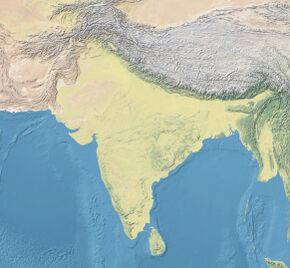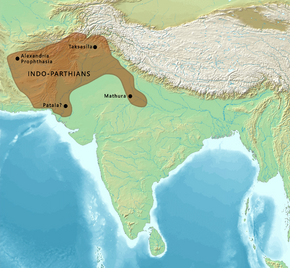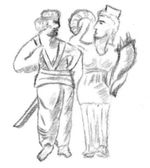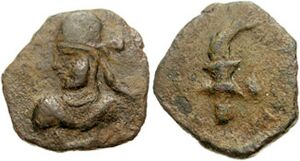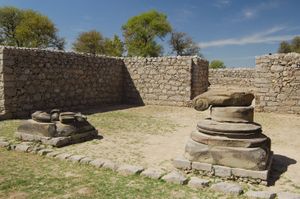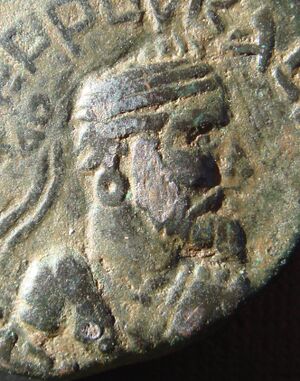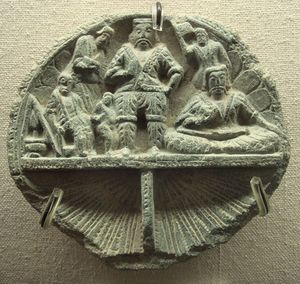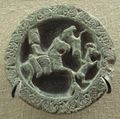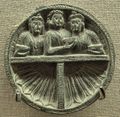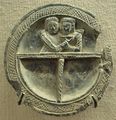المملكة الهندو-پارثية
المملكة الهندو-پارثية | |||||||||||||||||||
|---|---|---|---|---|---|---|---|---|---|---|---|---|---|---|---|---|---|---|---|
| 19 م–ح. 226 م | |||||||||||||||||||
Indo-Parthian Kingdom at its maximum extent, circa 40 CE, and neighbouring South Asian polities.[1] | |||||||||||||||||||
| العاصمة | تكسيلا كابول | ||||||||||||||||||
| اللغات المشتركة | الآرامية اليونانية (الأبجدية اليونانية) پالي (الخط الكاروشتي) السنسكريتية، پراكريت (الخط البراهامي) الپارثية (الكتابة الپارثية) | ||||||||||||||||||
| الدين | الهندوسية البوذية الزرادشتية الديانة اليونانية القديمة | ||||||||||||||||||
| الحكومة | ملكية | ||||||||||||||||||
| ملك | |||||||||||||||||||
• 19–46 | گوندوپارس الأول (الأول) | ||||||||||||||||||
• ؟–226 | Farn-Sasan (الأخير) | ||||||||||||||||||
| الحقبة التاريخية | القـِدَم | ||||||||||||||||||
| 19 م | |||||||||||||||||||
• انحلت | ح. 226 م | ||||||||||||||||||
| |||||||||||||||||||
المملكة الهندو-پارثية Indo-Parthian Kingdom حكمتها أسرة Gondopharid dynasty وحكام آخرون كانوا مجموعة من الملوك القدماء من آسيا الوسطى الذين حكموا أجزاء مما هو اليوم أفغانستان وپاكستان وشمال غرب الهند، أثناء أو قبيل القرن الأول الميلادي. في معظم فتراتها التاريخية، اتخذ الملوك الهندو-الپارثيون من تكسيلا (في منطقة الپنجاب الپاكستانية المعاصرة) مقراً لهم، لكن في السنوات الأخيرة من حياة المملكة انتقلت العاصمة إلى كابل وپشاور. عادة ما يشار لهؤلاء الملوك بالهندو-پارثيين، كما كانت عملاتهم مستوحاة في معظم الأحيان من الأسرة الأرساسية، لكن من المرجح أنهم ينتمون لمجموعة أوسع من القبائل الإيرانية التي كانت تعيش شرق پارثيا، ولا يوجد دليل على أن جميع الملوك ممن يحملون لقب گوندوپارس، والذي يعني "صاحب المجد"، كانوا على علاقة بهم.
The kingdom was founded in 19/20 when the governor of Drangiana (Sakastan) Gondophares[2] declared independence from the Parthian Empire. He would later make expeditions to the east, conquering territory from the Indo-Scythians and Indo-Greeks, thus transforming his kingdom into an empire.[أ][4] The domains of the Indo-Parthians were greatly reduced following the invasions of the Kushans in the second half of the 1st. century. They managed to retain control of Sakastan, until its conquest by the Sasanian Empire in c. 224/5.[5] In Baluchistan, the Paratarajas, a local Indo-Parthian dynasty, fell into the orbit of the Sasanian Empire circa 262 CE.[6]
The Indo-Parthians are noted for the construction of the Buddhist monastery Takht-i-Bahi (UNESCO World Heritage Site) in Mardan, Pakistan.
گوندفارس الأول وخلفاؤه
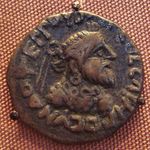
يبدو أن گوندوپارس الأول كان في الأصل حاكم لسيستان فيما يعرف اليوم بشرق إيران، ومن المرجح أنها كانت إمارة تابعة أو على علاقة بالأپراكاراجاس. He may have replaced previous Parthian governors of Seistan, such as Cheiroukes or Tanlismaidates.[7] These Parthian satraps had been ruling the region of Sakastan since the time when Mithridates II (124–88 BC) had vanquished the Sakas of the region.[8]
قام بغزوات في المملكة الهندو-سكوذيونية، وقد تكون بعد وفاة أهم حكامها أزيس. أصبح گوندوپارس حاكماً لمناطق أراكوسيا، سيستان، السند، الپنجاب، ووادي كابل، لكنه يبدو أنه لم يسيطر على الأراضي الواقعة وراء شرق الپنجاب.[9] أطلق گوندوپارس على نفسه لقب "ملك الملوك"، اللقب الپارثي الذي لا يعكس في حالته المعنى الصحيح بأن الامبراطورية الهندو-پارثية كانت مجرد إطار فضفاض: عدد من الأسر الصغيرة التي حافظت على مواقعها خلال الفترة الهندو-پارثية، من المرجح في مقابل اعترافهم بگوندوپارس وخلفائه. كانت هذه الأسر الصغيرة تشمل الأپراكاراجاسسيون أنفسهم، والساتراپات الهندو-سكوذيونية مثل زيونيسيس وراجوڤولا، بالإضافة إلى سكوذيين مجهولين كانا يسكون عملات معدنية مقلدة لعملات أزيس. كذلك، فقد سيطر الكساهارات على گجرات، وربما أنهم وصلوا حتى مشارف مملكة گوندوپارس.
Around 20–10 BC,[10] he made conquests in the former Indo-Scythian kingdom, perhaps after the death of the important ruler Azes. Gondophares became the ruler of areas comprising Arachosia, Seistan, Sindh, Punjab, and the Kabul valley, but it does not seem as though he held territory beyond eastern Punjab.[11] Gondophares called himself "King of Kings", a Parthian title that in his case correctly reflects that the Indo-Parthian empire was only a loose framework: a number of smaller dynasts certainly maintained their positions during the Indo-Parthian period, likely in exchange for their recognition of Gondophares and his successors. These smaller dynasts included the Apracarajas themselves, and Indo-Scythian satraps such as Zeionises and Rajuvula, as well as anonymous Scythians who struck imitations of Azes coins. The Ksaharatas also held sway in Gujarat, perhaps just outside Gondophares' dominions.
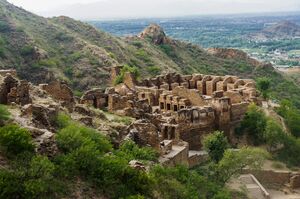
After the death of Gondophares I, the empire started to fragment. The name or title Gondophares was adapted by Sarpedones, who become Gondophares II and was possibly son of the first Gondophares. Even though he claimed to be the main ruler, Sarpedones’ rule was shaky and he issued a fragmented coinage in Sind, eastern Punjab and Arachosia in southern Afghanistan. The most important successor was Abdagases, Gondophares’ nephew, who ruled in Punjab and possibly in the homeland of Seistan. After a short reign, Sarpedones seems to have been succeeded by Orthagnes, who became Gondophares III Gadana. Orthagnes ruled mostly in Seistan and Arachosia, with Abdagases further east, during the first decades AD, and was briefly succeeded by his son Ubouzanes Coin. After 20 AD, a king named Sases, a nephew of the Apracaraja ruler Aspavarma, took over Abdagases’ territories and became Gondophares IV Sases[بحاجة لمصدر]. According to Senior, this is the Gondophares referred to in the Takht-i-Bahi inscription.[12]
There were other minor kings: Sanabares was an ephemeral usurper in Seistan, who called himself Great King of Kings, and there was also a second Abdagases Coin, a ruler named Agata in Sind, another ruler called Satavastres Coin, and an anonymous prince who claimed to be brother of the king Arsaces, in that case an actual member of the ruling dynasty in Parthia.
But the Indo-Parthians never regained the position of Gondophares I, and from the middle of the 1st century AD the Kushans under Kujula Kadphises began absorbing the northern Indian part of the kingdom.[13]
حكام طوران وساكاستان (160-230 AD)
The Indo-Parthians managed to retain control of Turan and Sakastan, which they ruled until the fall of the Parthian Empire at the hands of the Sasanian Empire circa 230 CE.[13] Pahares I (160-230 AD) was a ruler of Turan following the partition of the remains of the Indo-Parthian kingdom.[15] The kingdom of Sakastan was ruled by a second king with the name Sanabares II (160-175 AD).[16] The Kingdoms of Turan and Sakastan ended when they submitted to the Sasanian ruler Ardeshir I circa 230 CE.[16] These events were recorded by Al-Tabari, describing the arrival of envoys to Ardeshir at Gor:[16]
“Then he [Ardashir] marched back from the Sawad to Istakhr, from there irst to Sagistan, then to Gurgan, then to Abrasahr, Merv, Balkh, and Khwarizm to the farthest boundaries of the provinces of Kohrasan, whereupon he returned to Merv. Ater he had killed many people and sent their heads to the Fire temple of Anahedh he returned from Merv to Pars and settled in Gor. Then envoys of the king of the Kushan, of the kings of Turan and Mokran came to him with declarations of their submission."
الآثار والمصادر
The city of Taxila is thought to have been a capital of the Indo-Parthians. Large strata were excavated by Sir John Marshall with a quantity of Parthian-style artifacts. The nearby temple of Jandial is usually interpreted as a Zoroastrian fire temple from the period of the Indo-Parthians.
Some ancient writings describe the presence of the Indo-Parthians in the area, such as the story of Saint Thomas the Apostle, who was recruited as a carpenter to serve at the court of king "Gudnaphar" (thought to be Gondophares) in India. The Acts of Thomas describes in chapter 17 Thomas' visit to king Gudnaphar in northern India; chapters 2 and 3 depict him as embarking on a sea voyage to India, thus connecting Thomas to the west coast of India.
As Senior points out,[18] this Gudnaphar has usually been identified with the first Gondophares, who has thus been dated after the advent of Christianity, but there is no evidence for this assumption, and Senior's research shows that Gondophares I could be dated even before 1 AD. If the account is even historical, Saint Thomas may have encountered one of the later kings who bore the same title.
The Greek philosopher Apollonius of Tyana is related by Philostratus in Life of Apollonius Tyana to have visited India, and specifically the city of Taxila around 46 AD. He describes constructions of the Greek type,[19] probably referring to Sirkap, and explains that the Indo-Parthian king of Taxila, named Phraotes, received a Greek education at the court of his father and spoke Greek fluently:
"Tell me, O King, how you acquired such a command of the Greek tongue, and whence you derived all your philosophical attainments in this place?"[20]
[...]-"My father, after a Greek education, brought me to the sages at an age somewhat too early perhaps, for I was only twelve at the time, but they brought me up like their own son; for any that they admit knowing the Greek tongue they are especially fond of, because they consider that in virtue of the similarity of his disposition he already belongs to themselves."[21]
The Periplus of the Erythraean Sea is a surviving 1st century guide to the routes commonly being used for navigating the Arabian Sea. It describes the presence of Parthian kings fighting with each other in the area of Sindh, a region traditionally known at that time as "Scythia" due to the previous rule of the Indo-Scythians there:
- "This river (Indus) has seven mouths, very shallow and marshy, so that they are not navigable, except the one in the middle; at which by the shore, is the market-town, Barbaricum. Before it there lies a small island, and inland behind it is the metropolis of Scythia, Minnagara; it is subject to Parthian princes who are constantly driving each other out." Periplus of the Erythraean Sea, Chap 38[22]
An inscription from Takht-i-Bahi bears two dates, one in the regnal year 26 of the Maharaja Guduvhara (again thought to be a Gondophares), and the year 103 of an unknown era.[23]
Religion of the Indo-Parthians
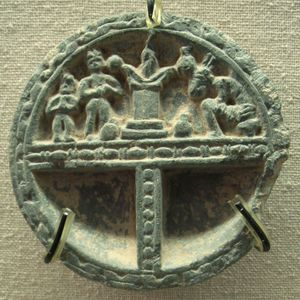
We do not know the religion of the House of Suren although we know they were in religious conflict with the Zoroastrian Arsacid dynasty.[24] Unlike the Indo-Greeks or Indo-Scythians, there are no explicit records of Indo-Parthian rulers supporting Buddhism, such as religious dedications, inscriptions, or even legendary accounts. Also, although Indo-Parthian coins generally closely follow Greek numismatics, they never display the Buddhist triratna symbol (apart from the later Sases), nor do they ever use depictions of the elephant or the bull, possible religious symbols which were profusely used by their predecessors. They are thought to have retained Zoroastrianism, being of Iranian extraction themselves. This Iranian mythological system was inherited from them by the later Kushans who ruled from the Peshawar-Khyber-Pakhtunkhwa region of Pakistan.
Coins of the Hindu deity Shiva have also been found issued in the reign of Gondophares I.[25][26][27]
Representation of Indo-Parthian devotees
On their coins and in the art of Gandhara, Indo-Parthians are depicted with short crossover jackets and large baggy trousers, possibly supplemented by chap-like over-trousers.[30] Their jackets are adorned with rows of decorative rings or medals. Their hair is usually bushy and contained with a headband, a practise largely adopted by the Parthians from the 1st century AD.[31]
Individuals in Indo-Parthian attire are sometimes shown as actors in Buddhist devotional scenes. It is usually considered that most of the excavations that were done at Sirkap near Taxila by John Marshall relate to Indo-Parthian layers, although more recent scholarship sometimes relates them to the Indo-Greeks instead.[32] These archaeological researches provided a quantity of Hellenistic artifacts combined with elements of Buddhist worship (stupas). Some other temples, such as nearby Jandial may have been used as a Zoroastrian fire temple.
Buddhist sculptures
The statues found at Sirkap in the late Scythian to Parthian level (level 2, 1–60 AD) suggest an already developed state of Gandharan art at the time or even before Parthian rule. A multiplicity of statues, ranging from Hellenistic gods, to various Gandharan lay devotees, are combined with what are thought as some of the early representations of the Buddha and Bodhisattvas. Today, it is still unclear when the Greco-Buddhist art of Gandhara exactly emerged, but the findings in Sirkap do indicate that this art was already highly developed before the advent of the Kushans.
Stone palettes
Numerous stone palettes found in Gandhara are considered as good representatives of Indo-Parthian art. These palettes combine Greek and Persian influences, together with a frontality in representations which is considered as characteristic of Parthian art. Such palettes have only been found in archaeological layers corresponding to Indo-Greek, Indo-Scythian and Indo-Parthian rule, and are essentially unknown the preceding Mauryan layers or the succeeding Kushan layers.[33]
Very often these palettes represent people in Greek dress in mythological scenes, but a few of them represent people in Parthian dress (head-bands over bushy hair, crossed-over jacket on a bare chest, jewelry, belt, baggy trousers). A palette from the Naprstek Museum in Prague shows an Indo-Parthian king seated crossed-legged on a large sofa, surrounded by two attendants also in Parthian dress. They are shown drinking and serving wine.
التماثيل البوذية
عُثر على التماثيل في سيركاپ في المستوى السكوذيوني- الپارثي (المستوى 2، 1-60 ق.م.) مما يدل على حالة الفن الگانداراني المتطورة بالفعل في ذلك الوقت أو حتى قبل الحكم الپارثي. التماثيل المتعددة، من تماثيل لآلهة هلينية، إلى نساك الگاندارانيين، تجمع بين ما يعتقد بأنه تمثيل مبكر لبوذا وبوذاسـِڤ. اليوم، لا يعرف تاريخ نشأة الفن اليوناني-البوذي في گاندارا على وجه الدقة، لكن الدلائل التي عثر عليها في سيركاپ تشير إلى أن هذا الفن كان متطوراً بشكل كبير قبل ظهور الكوشان.
الألواح الحجرية
انتقال البوذية عبر طريق الحرير

Some pockets of Parthian rule remained in the East, even after the takeover by the Sassanids in 226. From the 2nd century several Central-Asian Buddhist missionaries appeared in the Chinese capital cities of Loyang and sometimes Nanjing, where they particularly distinguished themselves by their translation work. The first known translators of Buddhist texts into Chinese are actually Parthian missionaries, distinguished in Chinese by their Parthian surname "An", for "Anshi", "country of the Arsacids".
- An Shih Kao, was a Parthian prince, who made the first known translations of Hinayana Buddhist texts into Chinese (148–170).
- An Hsuan, was a Parthian merchant who became a monk in China 181 AD.
- Tan-ti (c. 254), a Parthian monk.
- An Fajin (281–306), a monk of Parthian origins.
الحكام الهندو-پارثيون الرئيسيون
- گوندوپارس الأول (ح. 20 ق.م. – السنوات الميلادية الأولى) Coin
- گوندوپارس الثاني سارپندونس (السنوات الميلادية الأولى – ح. 20 م)Coin
- أبداگاسيس الأول (السنوات الميلادية الأولى – منتصف-القرن الأول الميلادي) Coin
- گوندوپارس الثالث گادانا، أورثاگنيس سابقاً (ح. 20 م - 30 م)
- گوندوپارس الرابع ساسيس، (منتصف القرن الأول الميلادي)
- أبوزانيس، (أواخر القرن الأول الميلادي)
- پاكوريس، (أوائل القرن الأول الميلادي) Coin
انظر أيضاً
الهامش
- ^ Schwartzberg, Joseph E. (1978). A Historical atlas of South Asia. Chicago: University of Chicago Press. pp. 21, 145, map XIV.1 (f). ISBN 0226742210.
- ^ Ghosh, Suchandra (2016-01-11), Dalziel, Nigel; MacKenzie, John M, eds. (in en), Indo-Parthian Kingdom, Oxford, UK: John Wiley & Sons, Ltd, pp. 1–2, doi:, ISBN 978-1-118-45507-4, https://onlinelibrary.wiley.com/doi/10.1002/9781118455074.wbeoe038, retrieved on 2023-01-28
- ^ Ellerbrock 2021, p. 117.
- ^ Rezakhani 2017, p. 35.
- ^ Olbrycht 2016, p. 25.
- ^ "New light on the Paratarajas" Pankaj Tandon p.29-35
- ^ Rezakhani 2017, p. 56.
- ^ Rosenfield, p129
- ^ The chronology of the Gondopharid kings has long been uncertain, predominantly based on coins. This reconstruction is based on "Indo-Scythian Coins and History IV" by Robert Senior, CNG 2006, as the four volumes of Senior's work provide an almost complete catalogue of the coinage of the period. Senior's chronology is based on the existence of only one king Azes, a theory that was vindicated when it was shown that a coin of the so-called Azes II was overstruck with a type attributed to Azes I (see Senior, "The final nail in the coffin of Azes II", Journal of the Oriental Numismatic Society 197, 2008).
- ^ Rosenfield, p129
- ^ A votive inscription of the 26th year of Guduvhara or Gondophares, is reported to have been found on a stone at Takht-i-Bahi, northeast of Peshawar with a date in the year 103 of an unspecified era reckoning. This era is likely to have been the Malva or Vikrama era, founded in 57 BCE, this would give a date of 20 CE for this king's ascension (see Hindu calendar). The stone was formerly in the museum at Lahore. The point is especially important for those Christians who consider that a germ of history is embedded in the Acts of Thomas.
- ^ أ ب Gazerani 2015, pp. 26-27.
- ^ Photographic reference: "The dynastic art of the Kushans", Rosenfield, figures 278–279
- ^ Mitchiner, Michael (1975). Indo-Greek and Indo-Scythian Coinage (in الإنجليزية). Hawkins Publications. p. 779. ISBN 978-0-904173-12-3.
- ^ أ ب ت ث Mitchiner, Michael (1978). The Ancient & Classical World, 600 B.C.-A.D. 650 (in الإنجليزية). Hawkins Publications. ISBN 978-0-904173-16-1.
Pakores was succeeded in the office of Great King by Sanabares (c. AD 135-160). The much reduced Indo-Parthian realm then split into its two geographical constituents. These now became the Kingdom of Turan whose king was named Pahares and the Kingdom of Sakastan ruled by a second king bearing the name Sanabares (c. AD 160-175). These two kingdoms, Turan and Sakastan, were to persist until the first Sasanian Emperor, Ardeshir I, about AD 230. Both then became vassal kingdoms within the Sasanian Empire. Tabari recorded the submission made by the King of Turan which transpired when Ardeshir was at Gor: then envoys of the king of the Kushan, of the kings of Turan and Mokran came to him with declarations of their submission.
- ^ Bracey, Robert (1 January 2012). "The Mint Cities of the Kushan Empire". The City and the Coin in the Ancient and Early Medieval World. BAR International Series 2402: 124.
- ^ see Senior, "The final nail in the coffin of Azes II".
- ^ Description of the Hellenistic urbanism of Taxila:
- "Taxila, they tell us, is about as big as Nineveh, and was fortified fairly well after the manner of Greek cities" (Life of Apollonius Tyana, II 20) Archived 2016-03-10 at the Wayback Machine
- "I have already described the way in which the city is walled, but they say that it was divided up into narrow streets in the same irregular manner as in Athens, and that the houses were built in such a way that if you look at them from outside they had only one story, while if you went into one of them, you at once found subterranean chambers extending as far below the level of the earth as did the chambers above." (Life of Apollonius Tyana, II 23) Archived 2016-03-10 at the Wayback Machine
- ^ (Life of Apollonius Tyana, II 29)
- ^ (Life of Apollonius Tyana, II 31)
- ^ Periplus of the Erythraean Sea, Chap 38
- ^ Rosenfield, p130.
- ^ Gazerani 2015, p. 111.
- ^ Gondophares I Indological researches in India: selected works of Prof. K.D. Bajpai [1]
- ^ Anthropological Papers of the American Museum of Natural History, Volume 46 Pg. 274 [2]
- ^ "Gondopharescoins".
- ^ Alternatively "Scythian prince drinking" in Pons, Jessie (1 January 2014). "The Figure with a Bow in Gandhāran Great Departure Scenes. Some New Readings". Entangled Religions: 52.
- ^ Betts, Alison; Vicziany, Marika; Jia, Peter Weiming; Castro, Angelo Andrea Di (19 December 2019). The Cultures of Ancient Xinjiang, Western China: Crossroads of the Silk Roads (in الإنجليزية). Archaeopress Publishing Ltd. p. 104. ISBN 978-1-78969-407-9.
- ^ Described in "Rome's enemies, Parthians and Sassanid Persians", ISBN 0-85045-688-6
- ^ "Parthians, from about the 1st century AD, seem to have preferred to show off their carefully tonsured hair, usually only wearing a fillet of thick ribbon; before then, the Scythian cap or bashlyk was worn more frequently". In "Parthians and Sassanid Parthians" Peter Willcox ISBN 0-85045-688-6, p12
- ^ Pierfrancesco Gallieri, in "Crossroads of Asia": "The parallels are so striking that it is not excluded that the objects discovered in Taxila and dated to between the 1st century BCE and the 1st century CE were in reality produced earlier, maybe by artisans who had followed the Greeks kings during their retreat from Bactria to India" p211 (in French in the original)
- ^ "Let us remind that in Sirkap, stone palettes were found at all excavated levels. On the contrary, neither Bhir-Mound, the Maurya city preceding Sirkap on the Taxila site, nor Sirsukh, the Kushan city succeeding her, did deliver any stone palettes during their excavations", in "Les palettes du Gandhara", p89. "The terminal point after which such palettes are not manufactured anymore is probably located during the Kushan period. In effect, neither Mathura nor Taxila (although the Sirsukh had only been little excavated), nor Begram, nor Surkh Kotal, neither the great Kushan archaeological sites of Soviet Central Asia or Afghanistan have yielded such objects. Only four palettes have been found in Kushan-period archaeological sites. They come from secondary sites, such as Garav Kala and Ajvadz in Soviet Tajikistan and Jhukar, in the Indus Valley, and Dalverzin Tepe. They are rather roughly made." In "Les Palettes du Gandhara", Henri-Paul Francfort, p91. (in French in the original)
المراجع
- "Les Palettes du Gandhara", Henri-Paul Francfort, Diffusion de Boccard, Paris, 1979
- "Reports on the campaigns 1956–1958 in Swat (Pakistan)", Domenico Faccenna
- "Sculptures from the sacred site of Butkara I", Domenico Faccena
وصلات خارجية
| الممالك الوسطى في الهند | ||||||
|---|---|---|---|---|---|---|
| خط زمني والفترة التاريخية |
Northwestern India | Indo-Gangetic Plain | الهند الوسطى | الهند الجنوبية | ||
| Upper Gangetic Plain | Middle Gangetic Plain
|
Lower Gangetic Plain
| ||||
| العصر الحديدي | ||||||
| الثقافة | فترة الڤديك المتأخرة | فترة الڤديك المتأخرة (Brahmin ideology)[ب] |
فترة الڤديك المتأخرة (Kshatriya/Shramanic culture)[ت] |
ما قبل التاريخ | ||
| القرن 6 ق.م. | گاندارا | كورو-Panchala | ماگادا | أديڤاسي (قبائل) | ||
| الثقافة | التأثير الفارسي-اليوناني | "التمدن الثاني" | ما قبل الهند | |||
| القرن 5 ق.م. | (الحكم الفارسي) | Shishunaga dynasty | أديڤاسي (قبائل) | |||
| القرن 4 ق.م. | (الغزوات اليونانية) | امبراطورية ناندا | ||||
| العصر التاريخي | ||||||
| الثقافة | انتشار البوذية | ما قبل التاريخ | Sangam period (300 ق.م. – 200 م) | |||
| القرن 3 ق.م. | امبراطورية مورايا | Early Cholas 46 other small kingdoms in Ancient Thamizhagam | ||||
| الثقافة | الهندوسية ما قبل الكلاسيكية[ث] - "Hindu Synthesis"[ج] (ca. 200 BC - 300 AD)[ح][خ] الملاحم - Puranas - Ramayana - Mahabharata - Bhagavad Gita - Brahma Sutras - Smarta Tradition Mahayana Buddhism |
Sangam period (استمرت) | ||||
| القرن 2 ق.م. | المملكة الهندو-يونانية | امبراطورية شونگا | Early Cholas 46 ممالك أخرى صغيرة في Ancient Thamizhagam | |||
| القرن 1 ق.م. | ||||||
| القرن 1 م | مملكة كونيندا | |||||
| القرن 2 | امبراطورية كوشان | |||||
| القرن 2 | المملكة الكوشانية الساسانية | امبراطورية كوشان | Western Satraps | Kamarupa kingdom | Kalabhra dynasty | |
| الثقافة | "العصر الذهبي للهندوسية"(ح. 320-650 م)[د] Puranas Co-existence of Hinduism and Buddhism | |||||
| القرن 4 | Kidarites | Gupta Empire | Kalabhra dynasty | |||
| القرن 5 | Hephthalite Empire | Alchon Huns | Kalabhra dynasty | |||
| القرن 6 | Nezak Huns | Maitraka | Adivasi (tribes) | Badami Chalukyas | ||
| الثقافة | Late-Classical Hinduism (ح. 650-1100 م)[ذ] Advaita Vedanta - Tantra Decline of Buddhism in India | |||||
| القرن 7 | Indo-Sassanids | Vakataka dynasty Empire of Harsha |
Mlechchha dynasty | Adivasi (tribes) | Pandyan Kingdom(Under Kalabhras) | |
| القرن 8 | Kabul Shahi | Pala Empire | Pandyan Kingdom | |||
| القرن 9 | Gurjara-Pratihara | Rashtrakuta dynasty | ||||
| القرن 10 | Ghaznavids | Pala dynasty | Kalyani Chalukyas | |||
مصادر ومراجع الجدول المصادر Sources
| ||||||
- Short description is different from Wikidata
- Pages using infobox country with unknown parameters
- Articles with unsourced statements from March 2021
- Articles with hatnote templates targeting a nonexistent page
- الامبراطورية الپارثية
- المملكة الهندو-پارثية
- تأسيسات 12 ق.م.
- انحلالات 130
- تأسيسات القرن الأول ق.م.
- دول وأقاليم تأسست في القرن الأول ق.م.
- دول وأقاليم انحلت في القرن الثاني
